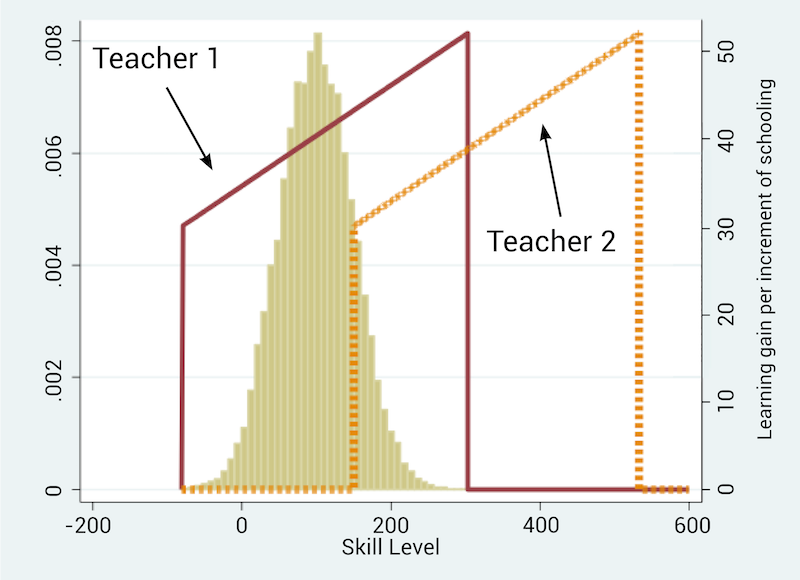Michelle Kaffenberger
Blavatnik School of Government, University of Oxford
Blog
Teachers with equal ability can have dramatically different learning outcomes and observed teacher value added.
RISE has produced much work on learning profiles, showing that learning varies substantially across countries and within countries; that learning levels on average are changing very slowly (if at all) over time; and using simulations to show that changing certain conditions, such as achieving equality of schooling or equality of learning conditional on schooling, would still leave many without basic skills. These basic facts present an important question: What drives these varying learning trajectories? Lant Pritchett and I, in recent work, develop a formal model that characterizes the instructional process that produces learning outcomes, which I presented recently at CIES.
An extended version of the deck I presented is available here, walking through the model and its components, and the simulations we run to produce varied learning profiles. Our preferred variation of the model can produce average learning outcomes ranging from OECD average PISA scores, to Zambia’s scores on the PISA-D (on which only 2 percent of 15-year-olds demonstrated proficiency in basic math).
We then apply the model to understanding teacher value added (TVA), as measures of TVA are measures of the learning outcomes produced by a teacher in a given year of schooling. Our simulations show that observed TVA is not just driven by teacher ability, but by other factors such as the pace of the curriculum and variation of student skills in their classrooms. Teachers with equal ability can have dramatically different learning outcomes and observed TVA.
For example, the two trapezoids in Figure 1 represent two teachers with identical ability to produce learning—represented by the heights of the trapezoids. The histogram underneath represents the initial distribution of skills among children in each teacher’s classroom. Teacher 1 (red trapezoid) is using a curriculum that is perfectly centered on the students’ skills, imparting an average of 42 points for his or her students. Teacher 2, meanwhile, is required to use a curriculum that is too advanced for her or his students’ skills; it is overambitious. Most of the children are outside the trapezoid, meaning they will learn nothing (an example would be curriculum focused on long division when most children in the class can’t yet recognize numbers). This teacher, who has the same ability to teach as teacher 1—they only differ in terms of the curriculum they are required to use—imparts only 5 points of learning on average to their students. The implication is that TVA does not necessarily reflect a characteristic of the teacher, but may reflect other parts of the system that are not coherent for learning.
Figure 1. Teachers with the same ability, one with centered curriculum and one with overambitious curriculum, will produce substantially different learning

The broader implication is that improving learning requires improving the right parameter. A teacher training program, for example, will have little to no impact if curriculum pacing is the underlying driver of low learning. Other factors, such as the heterogeneity of student skills in the classroom also matter. Diagnosing and prioritizing which parameter(s) are driving low learning, and adjusting those, is critical for maximizing learning outcomes.
Check out the deck for more details, and share your thoughts/feedback @michellekaffs
RISE blog posts and podcasts reflect the views of the authors and do not necessarily represent the views of the organisation or our funders.